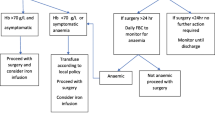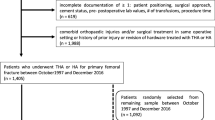Abstract
Purpose
Hip fractures in the elderly represent a major source of morbidity and mortality, with allogeneic blood transfusions (ABTs) associated with increased mortality. This study assesses the ABT requirements between the most common patterns of hip fracture; intertrochanteric (IT) and intracapsular (IC). The impact of operation type on transfusion rates was also assessed.
Methods
A retrospective study was performed for all patients entered on the national hip fracture database over 1 year in a teaching hospital. Records of 559 patients were reviewed and, following exclusion criteria, 474 were evaluated (198 IT, 276 IC). Baseline haematological parameters and ABTs were identified using hospital systems. Analysis was performed in SPSS, using independent samples t tests, one-way ANOVAs and Chi square tests.
Results
Patient groups were matched on gender, anaesthetic type, American Society of Anesthesiologist (ASA) grade, cognitive score and coagulation parameters. A significantly greater proportion of IT patients required an ABT during admission (39.4 vs. 22.5 %, p < 0.001). For IT fractures a greater proportion of patients required an ABT when undergoing an intramedullary nail operation compared with those requiring a dynamic hip screw (67.4 vs. 32.0 %, p < 0.001). Similarly, for IC fractures transfusion rates in patients undergoing an internal fixation were significantly lower than those undergoing hemiarthroplasty or arthroplasty (9.4 vs. 26.4 vs. 20.8 %, p = 0.033).
Conclusion
Patients with IT hip fractures are significantly more likely to require an ABT than those with IC hip fractures. Patients undergoing an intramedullary nail for IT fractures have significantly higher transfusion rates than for other types of operation.


Similar content being viewed by others
References
Bentler SE, Liu L, Obrizan M, et al. The aftermath of hip fracture: discharge placement functional status change & mortality. Am J Epidemiol. 2009;170:1290–9.
Lyons AR. Clinical outcomes & treatment of hip fractures. Am J Med. 1997;103:515–645.
Schilling PL, Hallstrom BR, Birkmejer JD, et al. Prioritizing perioperative quality improvement in orthopaedic surgery. J Bone Joint Surg Am. 2010;92(2):1884–9.
Lawrence VA, Silverstein JH, Cornell JE, et al. Higher Hb level is associated with better early functional recovery after hip fracture repair. Transfusion. 2003;43:1717–22.
Fiss NB, Kristenson MT, Kehlet H. Anaemia impedes functional mobility after hip fracture surgery. Age Ageing. 2008;87:173–8.
Williams JM, de Graeth AJ, Neilssen RG, et al. Haemoglobin predicts length of hospital stay after hip fracture surgery in older patients. MATURITAS. 2012;72(3):225–8.
Engoren M, Mitchell P, Perring E, et al. The effect of erythrocyte blood transfusions on survival after surgery for hip fracture. J Trauma. 2008;65:1411–5.
Ashworth A, Klein AA. Cell salvage as part of a blood conservation strategy in anaesthesia. Br J Anaesth. 2010;105(4):401–16.
Carson JL, Terrin ML, Noveck H, et al. Liberal or restrictive transfusion in high-risk patients after hip surgery. N Engl J Med. 2011;365:2453–62.
Foss NB, Kehlet H. Hidden blood loss after surgery for hip fractures. J Bone Joint Surg Br 2006; 88-B: 1053–9.
Lemaire R. Strategies for blood management in orthopaedic and trauma surgery. J Bone Joint Surg Br 2008; 90-B: 1128–36.
Smith GH, Tsang J, Molyneux SG, White TO. The hidden blood loss after hip fracture. Injury. 2011;42:133–5.
Dillon MF, Collins D, Rice J, et al. Preoperative characteristics identify patients with hip fractures at risk of transfusion. Clin Orthop Relat Res. 2005;439:201–6.
Desai SJ, Wood KS, Marsh J, et al. Factors affecting transfusion requirements after hip fracture: can we reduce the need for blood? Can J Surg. 2014;57:342–8.
Vincent JC, Baron JF, Reinhart K, et al. Anemia and blood transfusion in critically ill patients. JAMA. 2002;288:1499–507.
Blachman MA. Immunomodulation & blood transfusion. Am J Ther. 2002;9:389–95.
Klein HG, Spahn DR, Carson JL. Red blood cell transfusion in clinical practice. Lancet. 2007;370:415–26.
Opelz G, Terasaki PI. Improvement of kidney-graft survival with increased numbers of blood transfusions. N Engl J Med. 1978;299:799–803.
Patel MB, Proctor KG, Majetschak M. Extracellular Ubiquitin increases in packed red blood cell units during storage. J Surg Res. 2006;135(2):226–32.
Kadar A, Chechik O, Steinberg E, et al. Predicting the need for blood transfusion in patients with hip fractures. Int Orthop. 2013;37:693–700.
Rajesparan K, Biant LC, Ahmad M, et al. The effect of an intravenous bolus of tranexamic acid on blood loss in total hip replacement. J Bone Joint Surg Br. 2009;91B:776–83.
Carless PA, Henry DA, Moxey AJ et al. Cell salvage for minimising perioperative allogeneic blood transfusion. Cochrane Database Syst Rev 2006; 4: CD001888.
Author information
Authors and Affiliations
Corresponding author
Ethics declarations
Conflict of interest
Rhys Morris, Ulfin Rethnam, Bethan Russ and Claire Topliss declare that they have no conflict of interest.
Compliance with ethical requirements
An approval by an ethics committee was not applicable for this study.
Rights and permissions
About this article
Cite this article
Morris, R., Rethnam, U., Russ, B. et al. Assessing the impact of fracture pattern on transfusion requirements in hip fractures. Eur J Trauma Emerg Surg 43, 337–342 (2017). https://doi.org/10.1007/s00068-016-0655-8
Received:
Accepted:
Published:
Issue Date:
DOI: https://doi.org/10.1007/s00068-016-0655-8




